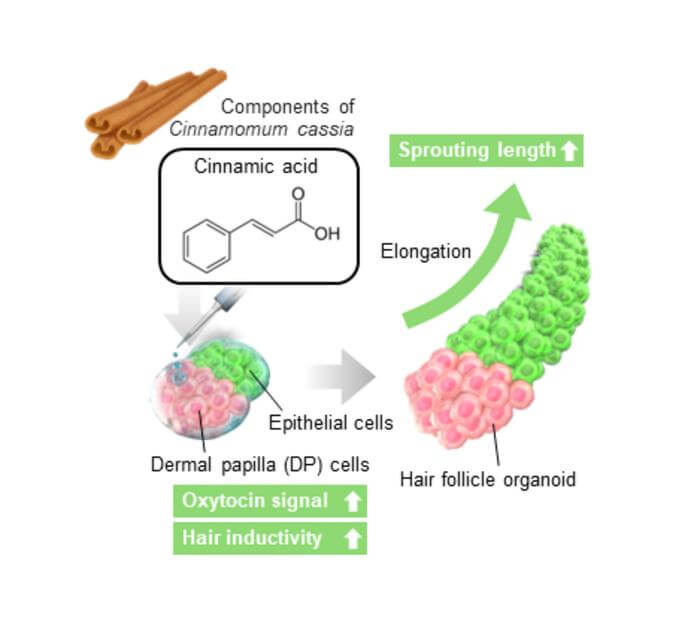YOKOHAMA, Japan — Hair loss, or alopecia, is a common concern that can take a significant emotional toll. While current treatments can help manage symptoms, they often come with side-effects and mixed results. But what if the key to fuller, healthier hair was hiding in your spice rack? Researchers from Yokohama National University in Japan suggest that cinnamic acid, a compound found in cinnamon, could offer a promising new approach to promoting hair growth.
Now, before you run to the grocery store and buy out all of the cinnamon products, it’s important to remember there’s lots of future research needed here — and simply eating more cinnamon won’t regenerate your hairline.
The research, published in Scientific Reports, builds on previous findings showing that the hormone oxytocin can stimulate hair growth by targeting a receptor called OXTR in hair follicles. However, oxytocin itself is a poor candidate for hair loss treatments, as it’s a large molecule that degrades quickly and can’t easily penetrate the skin.
Enter cinnamic acid. This small, stable compound is known to increase OXTR expression, potentially mimicking oxytocin’s hair-growing effects.
“These promising results may be useful for developing hair growth-promoting products targeting oxytocin,” says Junji Fukuda, the study’s corresponding author and a professor with the university’s Faculty of Engineering, in a statement.
To test their hypothesis, the researchers treated human scalp cells, called dermal papilla cells, with various concentrations of cinnamic acid. They found that at doses up to 500 μg/mL, the compound increased the expression of not only OXTR but also several key genes related to hair growth. Higher doses, however, started to damage the cells.
“At concentrations below 500 μg/mL, we observed a dose-dependent increase in the expression of oxytocin receptor expression and the genes associated with hair growth,” says Tatsuto Kageyama, the study’s first author and an assistant professor in the Faculty of Engineering at Yokohama National University.

To confirm that the effects were indeed due to OXTR activation, the team repeated the experiment with an OXTR blocker, which prevented the increase in hair growth genes. This suggests that cinnamic acid works by stimulating the oxytocin pathway.
But the real test came when the researchers grew actual human hair follicles in the lab using a special 3D culture system they had previously developed. These “hair follicloids” allow for more reliable testing of hair growth treatments than individual follicles, which can vary widely between people.
When treated with cinnamic acid, the follicloids grew hair shaft-like structures that were 1.25 times longer than untreated follicles. That’s comparable to the 1.3-fold increase seen with oxytocin treatment in the team’s earlier study.
“The identification of cinnamic acid as a specific component with hair growth-promoting properties holds great promise for enhancing the effectiveness of hair growth products,” Kageyama continues. “In addition, the new understanding of the mechanism of hair growth-promoting effects mediated by oxytocin signaling will provide new insights by hair care science and help accelerate the search for new drugs targeting oxytocin receptor expression in the field of drug discovery.”
The researchers caution that more work is necessary before cinnamon extracts start showing up in hair loss remedies. The next step is to test topical cinnamic acid treatments in mice with hair loss to determine optimal doses and identify any side effects.
Still, the findings offer an exciting new lead in the quest for better hair loss therapies. By targeting the oxytocin pathway with a small, stable molecule like cinnamic acid, researchers may be able to develop treatments that are more effective and easier to use than current options.
So the next time you catch a whiff of cinnamon, whether it’s in your latte or your cookie, take a moment to appreciate this humble spice’s hidden potential. With a little more research, it might just spice up your hair care routine and put some spring back in your follicular step.
StudyFinds’ Editor-in-Chief Steve Fink contributed to this report.
